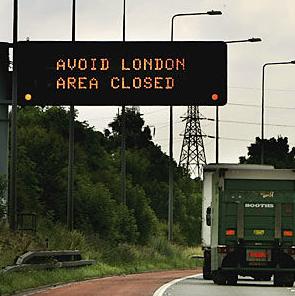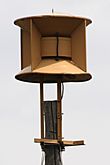Emergency communication system facts for kids
An Emergency communication system (ECS) is a special system that helps people and groups share important messages when something bad happens. These systems often use many different technologies, like phones and TVs, all working together. They make sure everyone gets the right information quickly during an emergency.
Contents
What's the Difference: Communication vs. Notification?
An emergency notification system sends messages in only one direction. Think of it like a loudspeaker. Examples include text message services, automatic phone calls like "Reverse 911," and town sirens for tornadoes. These systems just tell you something is happening.
Emergency Communication Systems (ECS) can do more. They often include notification tools, but they also allow people to talk back and forth. This means two-way conversations are possible.
Sometimes, "Emergency Communication Systems" also means the sender can give more details about an emergency. They can also tell people exactly what to do. An "Emergency Notification System" might only tell you about the emergency, perhaps without many details.
Other Names for Emergency Communication Systems
People use many different words for "emergency communication system." Most of the time, they mean the same thing. For example, "emergency communications" or "emergency telecommunications" are similar ideas.
|
|
|
Why We Need Emergency Communication Systems
Emergencies make it hard to talk to people. Communicating during a crisis is very different from normal times. When emergencies happen, things can change very quickly. Because of this, an emergency communication system needs special features.
Often, regular communication tools like email are too slow. Or they might not work everywhere. Every emergency is unique and hard to guess. So, a good ECS must be ready for any situation.
Real-Life Examples: When Systems Failed or Succeeded
- New York City World Trade Center Attack
- During the attack on September 11, 2001, regular phones stopped working well. Too many people were trying to use them. The 911 operators got confusing information and couldn't help much. Radios used by different emergency groups couldn't talk to each other easily. Many firefighters died when the buildings fell. They didn't get the same warning that police officers got from NYPD helicopters. People who had radio as a hobby helped a lot. Their radios worked differently and helped connect the emergency departments.
- London Subway Bombings
- On the day of the London Subway Bombings, mobile phone networks stopped working. They were full by 10:00 a.m., just an hour after the bombs. The damaged trains couldn't talk to the control center or emergency workers. This was because of a very old radio system. Emergency managers, like those from the London Ambulance Service, had to rely on mobile phones that weren't working. This happened because they didn't have enough digital radios. After the bombing, the London Assembly decided London needed a digital radio system that worked underground.
- 2011 Joplin, MO Tornado
- A very strong EF5 tornado hit Joplin, Missouri. It killed 161 people and hurt at least 990. Joplin is in a tornado area. Many people thought the tornado sirens were normal and ignored them. They waited for more information, like seeing the tornado or hearing a radio report. Later, a group suggested that warnings should make people understand how quickly they need to act. NOAA officials are now thinking about new ways to warn people about smaller tornadoes differently.
- Hurricane Katrina
- When Hurricane Katrina, a very powerful Category 5 hurricane, hit New Orleans, emergency communication systems were destroyed. This included power stations, internet servers, and mobile phone towers. Even 911 services stopped working. The Federal relief workers' satellite phones couldn't connect with other devices. A few AM radio stations kept broadcasting. One radio station, WWL, stayed on air from a closet. Amateur radio was very important in the rescue efforts. It worked well when 911 communications were broken.
- 2011 Tōhoku Earthquake
- The JMA's earthquake warning system used seismometers. It warned millions of people across Japan about the coming earthquake. Warnings went out on radio, mobile phones, and television. The tsunami warning system also alerted people quickly. However, the tsunami was much bigger than expected. In areas where things still worked, the Internet was available even if phone lines were not. In the hardest hit areas, satellite phones were often the only reliable way to communicate. The nuclear disaster at the Fukushima Daiichi Plant had many communication problems. There was no clear plan, internal talks were poor, and public information was slow. People soon lost trust in TEPCO and the nuclear industry. The main problem was the government not sharing accurate information quickly.
Important Features of Emergency Communication Systems
How Fast Messages Are Sent
An emergency is a sudden event that needs very quick action. So, any message about an emergency must be sent fast. This helps prevent damage or save lives. For example, during a school shooting at Virginia Tech, an email warning was sent about two hours after the event started. By then, the attacker was already inside a building. A loudspeaker announcement was made about twenty minutes after the violence began. In many emergencies, every second counts for sending messages.
How Easy It Is to Use
During an emergency, people need to send messages quickly and easily. They need to be sure the message goes through. The system should have a simple, secure way to send messages from anywhere. An ECS that is easy for regular people to use will be used successfully.
Sending emergency warnings is not something people do often. So, it's very important that the system is simple to use. Even though it's easy to use, the technology behind it should be very advanced. This is needed to make sure many different things can work together. It helps create and send emergency messages in many ways.
The system should also be easy to use for normal communications. This helps the people who own the system get the most value from it. It also helps users become familiar with the system. This way, they can use it well during a stressful emergency.
How Much It Costs
Generally, the cheaper an emergency communication system is to buy, set up, and keep running, the more popular it will become. The more common these systems are, the more likely they will be available to help in more places during emergencies. Modern mass-notification systems are also useful for everyday, non-emergency messages. Being able to use an ECS for both normal and emergency communications gives the owner the best value.
Giving Clear Instructions
A modern emergency communication system should do more than just give warnings. It must also give clear instructions about what to do. Research shows that people often need a second type of warning before they trust it and act. A system that can give warnings in many different ways can save lives and make an emergency less terrible.
Sending Messages to Different Groups
Emergencies often need different versions of the same message sent at the same time. For example, during a hostage situation, people inside a building might need instructions to lock doors. But police and other responders need to know that doors might be locked and other details.
Some modern ECS systems can send one message that gives full details to first responders. At the same time, they can give simpler instructions, like "lock doors," to people inside the building. By using one message that changes for different users, fewer messages need to be created and sent. This can save time.
Many Ways to Communicate / Backup Plans
There should be many ways to send emergency information. If one way doesn't work, others might. Also, studies show that people will check more than one way to get information before they act. People expect to be contacted in many ways. Besides phone calls and emails, they also expect text messages and faxes. People might also look at social media like Facebook and Twitter for updates.
Experts say that one warning is often not enough to make people act. People usually look for more information to confirm the warning. An effective warning needs to use many different ways to communicate, all working together. This means that when people get a first warning, they will look for more information. By having many ways to send a warning, people are more likely to react in the best way.
Many Parts Working Together

To work well, an emergency communication system should be able to connect and talk with other related systems. A big problem with old warning systems is that their parts don't work together. Because of this, sending a warning often takes a lot of time and effort.
An ECS might get an original warning from different places. For example, a building's fire system might send a notice that a smoke detector found smoke. A well-built ECS should get that notice. Then, it should turn it into a message that people in the building can understand. This helps them decide what to do to stay safe. Another example is the National Weather Service sending a severe weather warning. The ECS should turn that warning into a message and send it out, so people know what to do.
The ability to work together should include both old and new technology. Adding a new system that can't work with older equipment can cause problems.
Product vs. Service
An emergency communication system can be a product that an organization owns. For example, a paging network for a hospital. Or it can be a service owned by another company, like a cellular carrier's network. Both have good and bad points. However, services can have big problems for emergency communications. For example, SMS text messaging services might not be able to send many messages quickly. This makes SMS a poor emergency communication method for large emergencies.
On-Site vs. Off-Site Systems
"On-site" (or "on-premise") emergency communication systems are mostly or completely in the same place they serve. "Off-site" (or "non-premise") systems are in a different location. Both have good and bad points. Off-site systems are often slower than on-site systems. This is because they need to connect using data networks, like the Internet.
History of Emergency Communication Systems
As populations grew and technology changed, the ways we communicate during emergencies also changed.
Older Systems
In early America, emergencies might have been communicated by ringing church bells or people riding horses to deliver messages. Later, the telegraph became a very fast way to communicate. After that, radios, telephones, and sirens became common. After the surprise attack on Pearl Harbor in 1941, Civil Defense sirens became popular. They were used in many military bases and towns across America. A weakness of these old systems was that they couldn't really tell people what they should do.
Modern Systems
Today, modern tools like smartphones, flat-panel digital signs, GPS, and computer speech are changing how people get emergency alerts. These modern tools can give more specific instructions. So, instead of just telling people about an emergency, it's now possible to give exact steps on what to do. These instructions can even be customized for a person's specific situation and location. For example, smartphones with GPS can show a map of safe areas and directions to get there. This map might be different depending on where the person is. In a good system, all these special warnings and instructions can be sent with just one alert.
Images for kids
See also
 In Spanish: Sistema de comunicación de emergencia para niños
In Spanish: Sistema de comunicación de emergencia para niños







